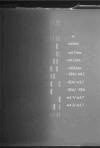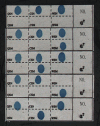Genotype analysis of 55,281 cases of thalassemia in northern Guangxi
- PMID: 38322564
- PMCID: PMC10839378
- DOI: 10.62347/CQDH5278
Genotype analysis of 55,281 cases of thalassemia in northern Guangxi
Abstract
Objective: To understand the genotype and distribution of thalassemia in northern Guangxi.
Methods: The study subjects were 55,281 individuals who came to the Affiliated Hospital of Guilin Medical University for genetic diagnosis of thalassemia from January 2012 to August 2023. All of their household registration was in the precincts of Guibei District and its affiliated counties. Red blood cell parameters and hemoglobin analysis were used for thalassemia screening. Gap-PCR, PCR-reverse dot blot hybridization (PCR-RDB), and multicolor melting curve analysis (MMCA) were used to identify common thalassemia genes. Multiplex ligation-dependent probe amplification (MLPA), Sanger sequencing, and third-generation single-molecule real-time (SMRT) sequencing were employed to identify rare thalassemia genes.
Results: Among the 55,281 samples, 16,442 (29.74%) were diagnosed with thalassemia. The detection rates of α, β, and α combined β-thalassemia were 18.57%, 9.99% and 1.18%, respectively. Among ethnical groups, allele mutation frequency of thalassemia was the highest in Zhuang (44.97%), followed by Yao (40.11%), Dong (31.33%), Han (29.85%), Miao (24.31%), and Hui (20.6%). A total of 11,659 alleles (21.09%) of 8 types of α-thalassemia were identified in 55,281 samples, primarily --SEA (53.9%), followed by -α3.7 (21.3%), including rare alleles: --THAI (0.45%) and HKαα (0.38%). A total of 6367 (11.52%) and 14 types of β-thalassemia alleles were identified, mainly CD41-42 (50.12%), followed by CD17 (22.22%), including rare alleles: βCD37 (0.16%) and Gγ+ (Aγδβ)0/βN (0.05%). A total of 31 genotypes were detected in 10,264 cases of α-thalassemia, and the main types were --SEA/αα (53.23%), -α3.7/αα (19.15%), and -α4.2/αα (7.21%). A total of 34 genotypes were detected in 5525 cases of β-thalassemia, and the main types were βCD41-42/βN (50.53%), βCD17/βN (21.77%), and βIVS-II-654/βN (12.16%). A total of 78 gene types were detected in 653 cases of α- and β-thalassemia, and the main types were --SEA/αα, βCD41-42/βN (18.68%) and -α3.7/αα, βCD41-42/βN (13.02%). There were 580 cases (5.65%) of HbH disease (α0/α+), and 4 cases of Hemoglobin Bart's Hydrops Foetus syndrome (--SEA/--SEA). In addition, there were 92 cases (1.67%) of intermedia or severe types of β-thalassemia (β0/β0, β0/β+, β+/β+), including 23 cases of combined α-thalassemia. Among the samples screened negative for thalassemia, 3.7% of them were found to carry thalassemia genes, and 91.35% of the genotypes were αWSα/αα, -α3.7/αα, and -α4.2/αα. In addition, 40.26% of αWSα/αα, 22.89% of -α3.7/αα, and 18.51% of -α4.2/αα had no hematological phenotype.
Conclusion: The population in northern Guangxi exhibited rich ethnic diversity, with high allelic carrying rates among the Zhuang, Yao and Dong ethnic groups. Thalassemia gene mutations are diverse, encompassing a variety of gene types, with α thalassemia predominating, notably the --SEA/αα gene type. The prevalence of intermedia or severe types of thalassemia is not low, but there are still some carriers of thalassemia in people who are initially tested negative.
Keywords: Thalassemia; genotype; minority; phenotype.
AJTR Copyright © 2024.
Conflict of interest statement
None.
Figures







Similar articles
-
Genotypes of thalassemia in children: an analysis of 30 417 cases.Zhongguo Dang Dai Er Ke Za Zhi. 2021 Aug 15;23(8):841-847. doi: 10.7499/j.issn.1008-8830.2104035. Zhongguo Dang Dai Er Ke Za Zhi. 2021. PMID: 34511175 Free PMC article. Chinese, English.
-
[Gene Mutation Types of Thalassemia in Chongzuo Childbearing-age Population of Guangxi Zhuang Autonomous Region of China].Zhongguo Shi Yan Xue Ye Xue Za Zhi. 2023 Dec;31(6):1804-1810. doi: 10.19746/j.cnki.issn.1009-2137.2023.06.031. Zhongguo Shi Yan Xue Ye Xue Za Zhi. 2023. PMID: 38071064 Chinese.
-
[Genetic Analysis of Thalassemia in Children in Liuzhou of Guangxi Zhuang Autonomous Region].Zhongguo Shi Yan Xue Ye Xue Za Zhi. 2024 Oct;32(5):1490-1495. doi: 10.19746/j.cnki.issn.1009-2137.2024.05.029. Zhongguo Shi Yan Xue Ye Xue Za Zhi. 2024. PMID: 39479837 Chinese.
-
[Analysis of Thalassemia Gene Mutation Types and Ethnic Distribution Characteristics in Hechi Area, Guangxi].Zhongguo Shi Yan Xue Ye Xue Za Zhi. 2024 Aug;32(4):1191-1196. doi: 10.19746/j.cnki.issn.1009-2137.2024.04.033. Zhongguo Shi Yan Xue Ye Xue Za Zhi. 2024. PMID: 39192418 Chinese.
-
Application of third-generation sequencing technology in the genetic testing of thalassemia.Mol Cytogenet. 2024 Dec 18;17(1):32. doi: 10.1186/s13039-024-00701-4. Mol Cytogenet. 2024. PMID: 39696632 Free PMC article. Review.
References
-
- Chen P, Lin WX, Li SQ. THALASSEMIA in ASIA 2021: thalassemia in Guangxi Province, People’s Republic of China. Hemoglobin. 2022;46:33–35. - PubMed
-
- Wang L, Zuo YJ, Lin L, Chen QL, Chen BY, Chen FQ, He S. Genotyping of thalassemia in Guangxi population. Chongqing Med. 2022;51:491–494.
LinkOut - more resources
Full Text Sources
Miscellaneous
